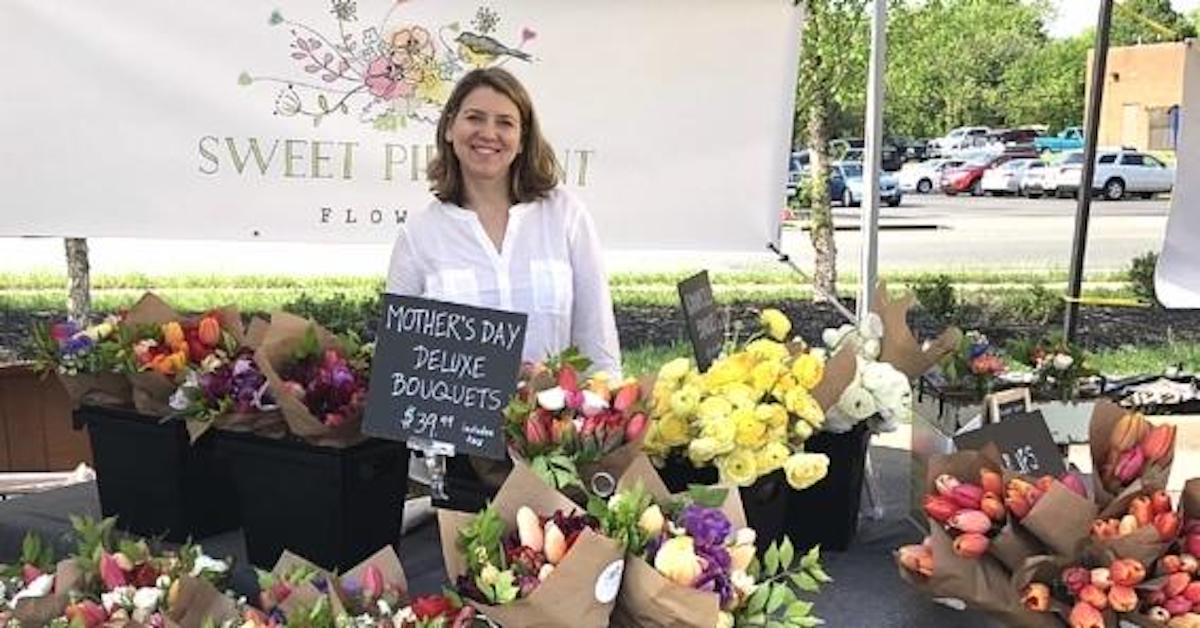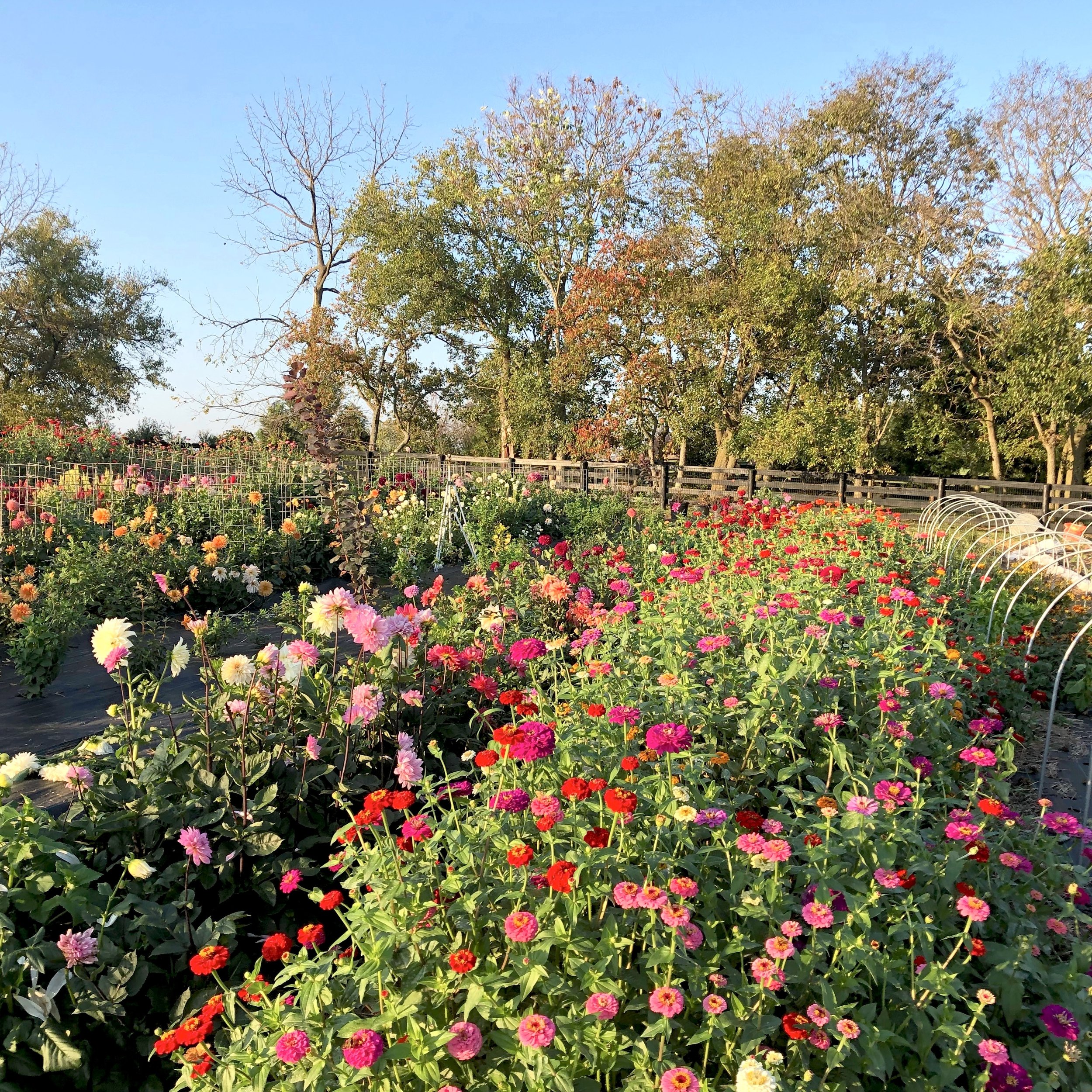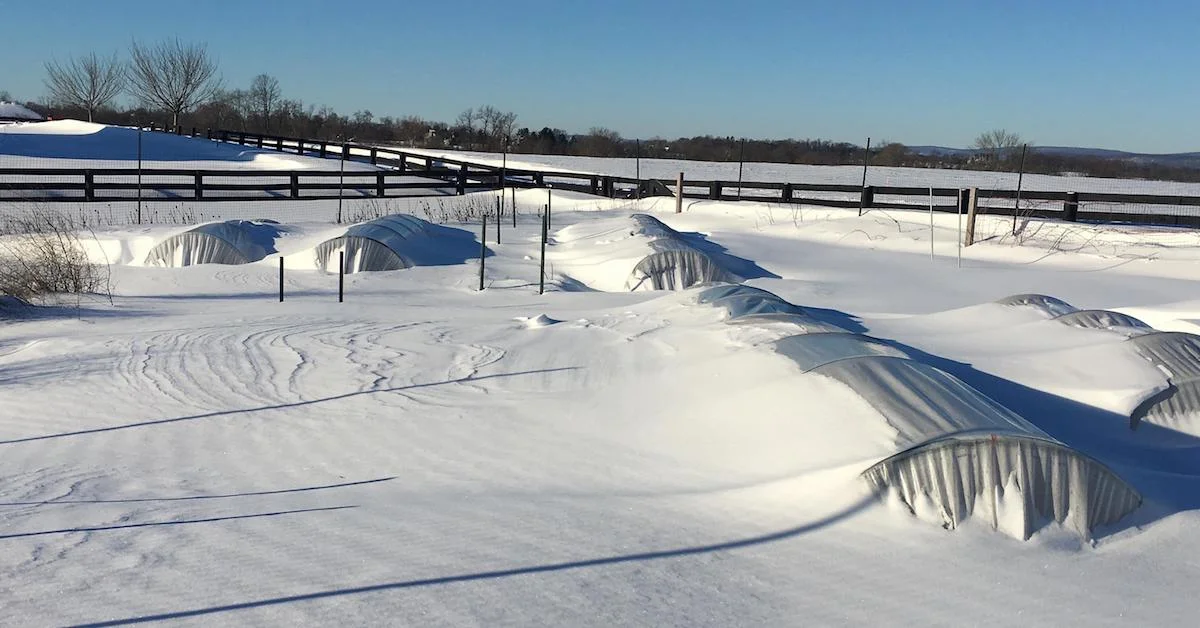A New Grower's Guide to Selling Flowers at a Farmers' Market
The night before my first time selling flowers at a farmers’ market, I didn’t sleep a wink.
While I was certainly anxious about the next morning, it wasn’t the nerves that kept me awake. It was the preparation—the harvesting, arranging, labeling, sign-making.
Selling Flowers in Your Community Market as a New Grower
For flower farmers who have figured out how to grow copious amounts of beautiful blooms, a farmers’ market is an attractive option for selling your cut flowers.
Selling directly to the consumer provides higher profit margins than selling to florists or wholesalers. Markets are also a good way to generate customers who will buy your flowers through other mechanisms (a bouquet subscription, for example, or through a pick-your-own operation if you have one).
For farmer-florists, a farmers’ market can be a conduit to a bride, mother of the bride, or event planners.
Starting or running a flower farm? Get the extra support you need with 5 flower growing resources sent straight to your inbox—for free. Sign up here.
This resource is a big guide, meant to truly help get you started off on the right foot.
But before we dig in to the details of selling flowers at a farmers’ market, if there’s something specific you need from this guide today, feel free to skip ahead using the links below!
Blooms Ready for Farmers’ Market Flower Bouquets
Plenty of challenges exist, too, of course. The prep time is significant, and if you don’t have a cooler, then you will have to harvest as close to market time as possible, pushing all of the necessary processing, arranging, labeling, and loading into the wee hours before market.
You’ll also probably harvest more than you ultimately sell at market—especially if you apply the vegetable farmer’s philosophy “pile it high; watch it fly” in order to create an eye-catching and bountiful display. Bad weather and other factors can dramatically diminish market traffic, yielding pitiful sales. Competition from other flower vendors, particularly those who price their blooms at or below wholesale prices, can reduce business significantly.
For many growers, the positives will greatly outweigh the negatives, and so I encourage you to try selling your flowers at your local market. Do some research first—hang out at a farmers’ market to get a feel for the other vendors, the customers, and the overall market vibe. If it feels like a good fit, find out who the market manager is and ask about the process for becoming a vendor.
Step 1: Applying to Sell Flowers at the Market
The market manager will have you fill out an application to sell at the market. Most of the information on the form will be quite straightforward, but be prepared to provide the following with your application (although every market is different and not all these items may be required):
Proof of insurance with your application (you may need to add the market as an additional insured party on your policy)
Your federal Tax ID number
In some areas, you may need a business license
Once your application is accepted, start thinking about how you’ll collect payment. You’ll need two things:
A cash drawer with enough small bills to make change
A credit card reader that can be used with a phone or other mobile device (You don’t want to turn away a customer who’s ready to make a purchase but doesn’t have enough cash!)
Single Flower Wrapped Farmers’ Market Bouquet
Step 2: Decide What Flowers to Sell at the Farmers’ Market
Now you get to decide what to grow! Keep in mind that what sells at the farmers’ market may be very different from your other sales channels. For example, while current wedding trends favor white, blush, and “muddy” colors, farmers’ market customers often want brighter colors.
Here Are a Few Farmers’ Market Flowers Tips:
When preparing mixed bouquets for market, remember to go outside your personal preferences to include mixes that have far more contrast. But don’t assume that your buyers are just looking for bright mixes of zinnias! Many of my customers favor a much more restrained palette. Try different things, pay attention to what sells (and what doesn’t), and adjust accordingly.
Apply your observational skills to determine how to bundle your flowers: mixed bouquets versus straight bunches versus single stems. All markets are different, and you have to figure out what is most profitable for you. For me, I’ve found that a combination of mixed bouquets and by-the-stem works best. Interestingly, my most profitable item is a miniature arrangement in small milk jars. I call them Powder Room Posies (TM). When they sell out quickly, their small size enables me to rapidly make more during quiet moments at the market.
If you plan to sell at market every week—and some markets will require that you do—then you will need to pay careful attention to your planting plan and get serious about succession planting. The level of difficulty in ensuring that you have a good mix of saleable blooms (and foliage!) throughout the season is far higher than just turning out big flushes of flowers several times a season. You’ll also want to decide whether you want to sell only during the peak season (generally summer) or to use tunnels, greenhouses, or other mechanisms to extend your harvest into spring and late fall. Some flower farmers sell virtually year round, offering holiday wreaths, succulents, and other products.
For a complete guide on Growing and Selling Flowers for Market, check out our online fast-track class. You’ll learn everything from crop planning and harvesting tips to how and where to sell.
Last year, I made the decision to focus only on the so-called shoulder seasons, based on two factors. First, another flower vendor started selling at the same market at below-wholesale prices during the peak months. As a result, I saw my business during these months drop. Since she didn’t appear at market until early summer, I decided to focus on the spring market, and next year I also plan to sell late into the fall. I did this by using tunnels, which enable me to grow early season crops (ranunculus, anemones, poppies, etc.) and by succession-cropping tulips and narcissus.
And the second factor in this decision was, in my area, customers were far more willing to buy market flowers at times of the year when they didn’t have them growing in their own backyards. My second year at market I made more money by focusing only on the early market (which included both Easter and Mother’s Day) than I did selling all summer long the year before.
Flower Farmer Sharon Hays’s Cheerful Market Booth
Step 3: Draw Customers in With an Eye-Catching Booth for Selling Flowers
For starters, to create an eye-catching booth, you want a weatherproof sign that proudly and prominently displays your company name and logo (don’t forget the string or bungee cords you’ll need to attach it to the tent).
Think about how you can make your market display fit your overall aesthetic. For some, that might be gingham and burlap or a floral motif. I personally prefer a more monochromatic and streamlined backdrop, and so I use only black buckets (you can get them for free at Trader Joe’s—just call first to inquire), grey tablecloths, and black signs with white text.
3 Basics You’ll Need to Sell Your Farmers’ Market Flowers:
A tent to provide shade
A table
Benches to display your merchandise
Consider the following when purchasing these items:
First, you want a sturdy tent with high enough vertical clearance that shoppers don’t have to duck to get under it—in other words, don’t assume you can repurpose your family’s beach canopy.
Second, you need a way to anchor your tent so that it doesn’t blow away when the wind gusts. If you’re on grass or dirt, the stakes that are included with most tents might work. But if you’re on a hard surface (like in a parking lot), you’ll need heavy weights. The best ones I’ve seen are a relatively easy DIY project—coffee cans filled with concrete and an embedded hook. Bungee cords are used to attach the weights to all four legs of the tent.
Lastly, card tables are great, because they fold up for easy transport, but make sure you buy heavy-duty ones. Remember, your flowers will be sitting in buckets of water—and water is heavy!
Prepare to Bring These Items to the Market:
Signage to display pricing is critical; it may be required by your market, but even if not, it makes everyone’s life easier. Some customers don’t want to ask how much something costs, and they’ll walk away from a purchase rather than ask. In addition, when you get busy selling bunches, you don’t want to have to interrupt a transaction to answer another customer’s pricing questions.
In addition to the items for my market booth and pricing signage, I bring the following with me to every market:
Extra bungee cords
Hammer (one time I had to bang a dent out of a table leg to get it to stand up correctly!)
Extra buckets
Extra water (accidents happen!)
Floral snips
Plenty of extra bouquet sleeves, stickers, etc.
I have a checklist that I run through each time before leaving for market. Every single item on it gets checked. Every. Single. Time.
Be prepared for the amount of work it takes to set up your market stall, and—if at all possible—enlist a helper. The fact that our product has to be kept in water (did I mention that water is heavy?) means it takes hustle and a little muscle to get everything set up. Leave yourself plenty of time to set up. I strongly recommend that you practice setting up before your first market and time yourself to see how long it takes.
Gorgeous Cut Tulips for Market
Step 4: Pricing—The Most Important Part of Your Farmers’ Market Plans
For many new growers, pricing may be one of the things you think the least about—and yet it’s one of the most important. It is critical to your bottom line, to other growers in your area, your farmer-florist or floral designer salary, and to our industry. There are two common mistakes new flower growers make when pricing their flowers for public sale.
Mistake #1: Underpricing Your Floral Product
The most common mistake that new growers make is underpricing their product. It’s a misstep that is usually based in fear and lack of awareness. The fear stems from worrying that your product isn’t “good enough,” that customers will challenge you, and, of course, that potential customers may not buy your product.
Mistake #2: Pricing Below Market Norms
At the same time, new growers may think that it’s okay to price flowers at below-market prices. (Especially those who, like me, are growing and selling flowers as a side hustle, and thus have the financial safety net of an off-farm paycheck.) But you are putting other flower farmers (who may be drawing their family’s sole income from their flower business) at risk—in addition to ensuring that your business is not fiscally sustainable.
To avoid both of these issues, ensure that you charge prices that take into account your costs. You can also avail yourself of multiple sources of price information, such as from the USDA and, if you’re a member, the Association of Specialty Cut Flower Growers.
If appropriate, you can also contact a nearby wholesaler and get their price list (as a farmer-florist, I occasionally need to augment the flowers I grow for an event, so I signed up with a local wholesaler).
The bottom line is this: You should never, ever sell your flowers at (or below!) wholesale prices when selling at a farmers’ market.
Step 5: Enjoy Yourself—And Sell Those Flowers!
Despite the long hours that it takes to prepare for market, drive, set up, drive home, and then unload, I truly enjoy the farmers’ market. Most people who approach your flower stand—even if they are buying flowers for someone else—like flowers. Some of them really love flowers.
As an introvert, I was convinced that selling at market would be pure torture. But I’ve found that not to be the case at all. One of my favorite things to do is to try to rapidly identify different types of potential customers. Here are a few quick tips to help you do so.
If someone approaches your booth looking a little uncertain, ask them who they’re shopping for—themselves or someone else? Often the answer is something along the lines of “I want to get my wife/girlfriend/significant other some flowers, but I don’t know what to get.” Based on the answers to a couple of gentle questions, you can usually hone-in on a good recommendation.
You may also encounter the customer who knows their roses from their ranunculuses and wants to make their own arrangements. They can often be identified by the lack of hesitancy they show in approaching your booth. Often, they’ll start asking questions before they’re even inside the tent: Are those parrot tulips? How do you keep the Japanese beetles from devouring your sunflowers? These customers often buy by the stem. They also really enjoy talking about flowers and love soaking up information about your cultivation practices and telling you about their own growing successes or failures.
When in doubt about which type of customer you’re interacting with, you can open with this line: “Everything you see here was grown on our farm here in [insert county or city you grow in].” It almost always leads to a conversation, and conversations almost always lead to sales!
Wrapped Farm Flower Bouquet
By far my favorite interactions at market are with the shoppers for whom flowers trigger powerful memories of gardens they played in as a child or a favorite rose bush that they coddle all year in order to produce a fleeting harvest of blooms. Even though some of these people don’t buy anything at all, I enjoy seeing their reactions to the blooms in my market stall and talking with them about our shared passion for flowers.
After all, I’m in this business because I love flowers (and I bet you are, too!), and selling at a farmers’ market is an opportunity to spend half a day talking with people who are almost as infatuated with them as we are.











